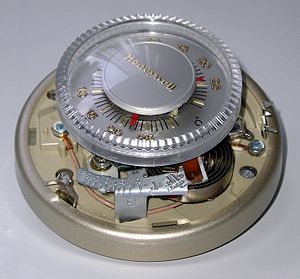Using the Thermostat to Reduce Summer Energy Costs

English: Honeywell thermostat for building (open). Français : Un Thermostat pour la maison. Nederlands: Honeywell thermostaat voor centrale verwarming in huis (open). (Photo credit: Wikipedia)
The dreaded increase in our electric bill that occurs during the summer months is not really preventable, outside of enduring an extremely uncomfortable summer. Sure we could shut off the thermostat and live “off the grid” for a while, but for most of us, paying the extra 30 or 40 dollars every month is well worth being able to keep the house below 80 degrees.
While it is largely responsible for our electric bill, the thermostat is one of the most powerful weapons that modern technology has ever afforded us in our constant combat of extreme temperatures. In fact, many of them are now designed to work within a tremendous amount of efficiency and relatively low costs.
So while we might get a few days in the spring and fall where we can cut the thermostat off and just throw open the windows, most days of the year don’t allow that to happen.
Instead of lamenting the necessity of our thermostat, we’d be far better off learning how to utilize it to reduce and put a “cap” of sorts on our summer energy costs.
The way you do this, is by simply knowing a little bit about what temperatures you’re willing to tolerate indoors and when to give the thermostat a break from insuring that temperature.
What’s your comfort zone?
The first thing you need to figure out is what’s your tipping point in terms of temperature. For example, some people might feel pretty comfy at 76 degrees, while others need to see something closer to 70 or 71 to feel cooled off. It all just depends on your body.
Once you make that assessment jot that down on a piece of paper as your “At Home” temperature:
At Home: 72 degrees —
Now all this means, is that when you’re at home and the outside temperature is higher than 72 degrees, you’ll have the thermostat on and set to this number. It also means that there are two events that you need to watch out for.
1. Leaving the house — When you leave the house, there’s no reason to keep it at exactly your comfort zone temperature, because of course, you’re not there to even enjoy it.
2. The temperature outside drops beneath 72 degrees — If the temperature outside is ever lower than what you have your thermostat set to, than you might be able to turn off your thermostat completely.
When the Thermostat Needs Adjusted
Now, the two scenarios I’ve already listed are the only situations where you would need to even think about touching the thermostat. However, they’ll happen fairly often, and if you’re diligent, you’ll be able to save a lot of money on your electricity costs as a result. Let’s take both scenarios one at a time.
Leaving the house — If you’re leaving and plan to be gone for an hour or two, you should move the thermostat three degrees higher than what it’s usually set at. In our example, it was set at 72, so now we’d move it to 75. Any higher means that it’ll take heavier work to get the house back to 72 when you come home, which would likely wipe out the savings while you were gone.
Although this does require some guess work, a good policy to have in place is that the longer you’re gone, the more breathing room you’d want to give your thermostat. If you’re going to be gone for several days, you can feel free to give it a good ten degree cushion as you’ll be gone long enough to make the big cool-down worth it.
Temperature Outside Drops — Having an outside thermometer handy can really help you be more efficient and accurate about when to make this move. While it’s hard to predict, you want to wait for a time when the temperature drops and stays below whatever temperature you have your thermostat set for. One of the most typical times this will happen is in the evening. You can bet that if it’s 72 degrees or lower at 8 o’clock in the evening, it’s not going to get much warmer until the next day.
In that situation, go ahead and turn the thermostat off to avoid any usage until the next day. You might say, “But if it’s below 72, won’t the thermostat stay off anyways?” It might, but you’ll probably have the odd jump to 73 or 74 degrees which will cause the air to kick back on.
Leaving the thermostat off through the night will help prevent that.
While it’s impossible to plan for all the opportunities, you can still save a lot of money during the summer with some simple planning and attention to detail. Don’t assume that your pocketbook is at the mercy of your own comfort when it’s hot outside. Make your thermostat your teammate and use it to cut down on your electric bill.
Kurt Cerrato is a home improvement consultant. His articles mainly appear on home improvement blogs where he enjoys sharing his ideas. Visit the link to learn more about portable air conditioners.

Category: Saving Energy, Saving Money






